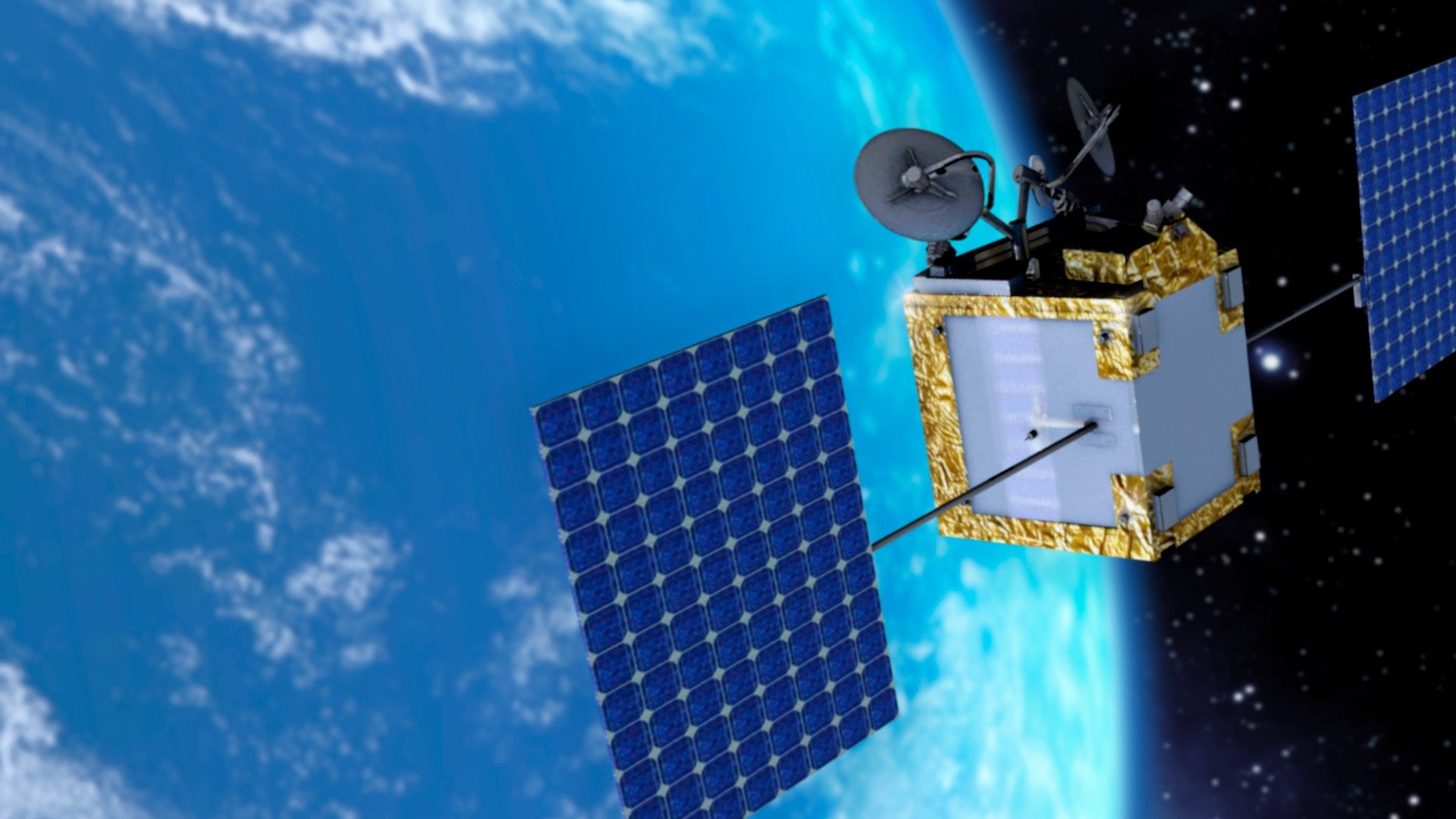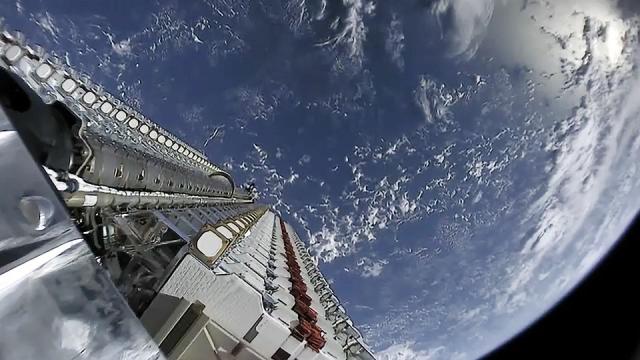Satellite swarms built and operated by SpaceX and OneWeb are poised to fundamentally alter the way in which we access the internet and where we connect to the grid. On the surface, the two internet service offerings would seem to be in competition with each other, but this isn’t exactly the case.
On Saturday, March 25, India’s space agency successfully delivered 36 OneWeb satellites to low Earth orbit, raising the total constellation to 616 functioning units, according to statistics compiled by Harvard-Smithsonian astrophysicist Jonathan McDowell. The London-based company says the first phase of the project is now complete and that, after some preliminary tests, it will make global service coverage available before the year is over.
OneWeb is one of several internet satellite constellations either in operation or development, with SpaceX’s Starlink being the most prominent. Both companies are building internet satellite constellations in low Earth orbit to provide low-latency, high-bandwidth internet communication services to any location on Earth, but their target markets aren’t the same. And the newer OneWeb has just several hundred satellites in orbit, while the more established Starlink boasts several thousand. It’s important to realise, however, that OneWeb is just getting started.
What is Starlink?
Elon Musk may be an overpromising huckster and Twitter-ruining egomaniac, but he’s not one to squander a good opportunity. Equipped with his own rocket company, the SpaceX CEO initiated the process of affordably launching satellites en masse to build an internet satellite constellation to reduce or outright eliminate internet dead zones around the world. So in addition to being an aerospace firm, SpaceX is now a satellite manufacturer and internet service provider.

SpaceX announced the Starlink project in 2015 with a stated purpose to meet underserved areas of the globe. At the time, Musk said: “We’re going to try and do for satellites what we’ve done for rockets,” adding that profits from Starlink would be used to fund his plan to colonise Mars.
How does Starlink work?
Starlink satellites connect directly to flat user terminals, allowing customers to directly access the internet, whether they’re at home, in an RV, or at a campground. For users in the United States, the service currently costs around $US110 ($153) per month. Standard hardware to support connectivity costs $US599 ($832), while a high-performance version costs $US2,500 ($3,471). Not cheap, and fair to say this offering doesn’t appeal to everyone.
T-Mobile recently partnered with SpaceX to provide its customers with text coverage both within and outside of T-Mobile’s network. The plan is to eventually include voice and data coverage. For this to work, however, SpaceX will need to equip Starlink satellites with a direct-to-cellular system that still requires FCC approval.
Scientists have been using Starlink while conducting field work in Antarctica, and it’s proving useful in Ukraine’s struggle against invading Russian forces. Starlink has attracted the attention of the U.S. Defence Department and China, the latter of which sees it as a potential security threat.
How many Starlink satellites are there?
Since 2019, Falcon 9 rockets have been steadily adding to the satellite swarm, delivering upwards of 50 Starlinks with each launch. Currently, SpaceX has 3,867 Starlink satellites working in low Earth orbit, according to McDowell. The company has Federal Communications Commission permission to launch 4,408 Ku-band spectrum satellites and 7,500 second-generation V-band satellites, the latter of which will work at altitudes ranging from 326 to 332 miles (525 to 535 kilometers) above the surface. To date, Starlinks have worked in altitudes of 211 to 382 miles (340 to 614 km), which is very low in general and exceptionally low for what is technically a communications satellite.
The company is still waiting for FCC approval on the remaining 22,488 Gen2 Starlink satellites it’s hoping to deploy. The FCC deferred its decision on the remaining units to “protect other satellite and terrestrial operators from harmful interference and maintain a safe space environment, promoting competition and protecting spectrum and orbital resources for future use,” the FCC said in its December 2022 order authorization. The immense size of the megaconstellation has prompted concerns from astronomers, who worry that the bright satellites pose a threat to science.
The process of delivering upgraded Gen2 satellites to orbit has been pushed back as a result of delays with SpaceX’s Starship megarocket. Falcon 9s cannot deliver the oversized Gen2s to orbit, so in the meantime the company has created smaller versions known as V2 Minis. The first batch went to space earlier this year, but they appear to be experiencing problems, which Musk said was to be expected.
What is OneWeb?
Founded in 2012 under the name WorldVu, OneWeb began the process of building its constellation in 2020. It’s been a rough ride for the British company, however, with OneWeb declaring bankruptcy in March 2020 and citing the covid-19 pandemic as a major factor. The OneWeb constellation was just 10% complete at the time. The company emerged from bankruptcy in late 2021 thanks to hefty investments from the UK government, India’s Bharti Enterprises, Hughes Network Systems, and SoftBank Group.
The investments allowed OneWeb to continue with its project, with its satellites going up on Russian Soyuz rockets as per usual. But then Russia invaded Ukraine, throwing the project into turmoil once more. Western sanctions prompted the Kremlin to stop launching OneWeb satellites, and it refused to return 36 units, causing OneWeb to lose hundreds of millions of dollars. In response, the company turned to SpaceX and India Space Research Organisation for launch services and hasn’t looked back, merging with French satellite operator Eutelsat in July 2022 and completing its phase one constellation on March 25.

Similar to SpaceX, OneWeb says its satellite constellation is “capable of serving broadband-style data speeds to any corner of the world” and that “[u]nconnected and underserved communities” will be able to “join the global community for the first time, through the OneWeb system and connectivity solutions.”
Unlike SpaceX, however, OneWeb will not sell its services directly to households. The company will instead seek partnerships with telecom operators, internet service providers, and any other organisation that sells internet services, whether to businesses or homes. So while you may never deal directly with OneWeb, your ISP may eventually choose to tap into the OneWeb network once it becomes available. And in fact, OneWeb has already forged an agreement with AT&T in the United States.
OneWeb CEO Neil Masterson doesn’t consider Starlink a pure competitor, given his company’s business-to-business model and focus on enterprise customers. “There are some areas where we will compete, I suspect, particularly around serving governments, but governments will always buy more than one service,” Masterson told CNBC in March 2021.
OneWeb plans to make its platform available to four primary sectors: aviation, maritime, enterprise, and government. “I think there’ll be multiple players who will be able … to be successful in addressing their market,” said Masterson to CNBC. To which he added: “We provide fibre where there is no fibre.”
Potential OneWeb competitors include Omnispace, AST & Science, and Amazon’s upcoming megaconstellation, known as Kuiper.
How does OneWeb work?
OneWeb satellites are built by the appropriately named OneWeb Satellites, a joint venture that includes European aerospace company Airbus. The satellites are currently working within 12 orbital planes, with 49 units in each plane, not including spares. The company’s ground network will consist of 50 to 70 gateway sites positioned around the world. Client companies will connect to the satellites using OneWeb end user terminals, in which a terminal consists of a satellite antenna, a receiver, and a customer network exchange (CNX) unit. The CNX connects the user terminal “to the customer’s network which in turn connects to end-user devices including laptops, smartphones, sensors, and more,” according to Canada Satellite.
OneWeb satellites operate in higher orbits than Starlinks, working 750 miles (1,200 km) above the surface. Still, both OneWeb and Starlink work far closer to the ground than traditional geostationary communications satellites, which operate at distances 22,370 miles (36,000 km) from Earth. The close proximity results in low latency, allowing your favourite websites and apps to load quickly and smoothly.
For OneWeb, this is translating to latency less than 100 milliseconds across the network and speeds greater than approximately 200 Mbps. SpaceX claims latencies between 25 to 50 milliseconds and expected download speeds between 20 and 250 Mbps, depending on the package and other factors. That said, not everyone gets great service with Starlink, and the service is slowing down as the user base increases. Hence SpaceX’s insatiable craving for more satellites.
Speaking of which, OneWeb is not stopping at 616 Ku-band satellites. For phase two, the company plans to deploy 6,372 satellites, raising the total satellite swarm to 7,000 units, down from the 48,000 it proposed in 2020.
Another similarity between OneWeb and SpaceX is that they’re not the only game in town. The new race for space is the result of affordable access to Earth orbit, prompting other companies to think along the same lines. Amazon’s Project Kuiper, Iridium Certus, Telesat, Facebook Athena, and Alphabet Loon are also vying for a piece of the megaconstellation pie.
Which companies will succeed and how these services may improve your ability to access the internet remain open questions, as are the impacts of these satellites on astronomy.
